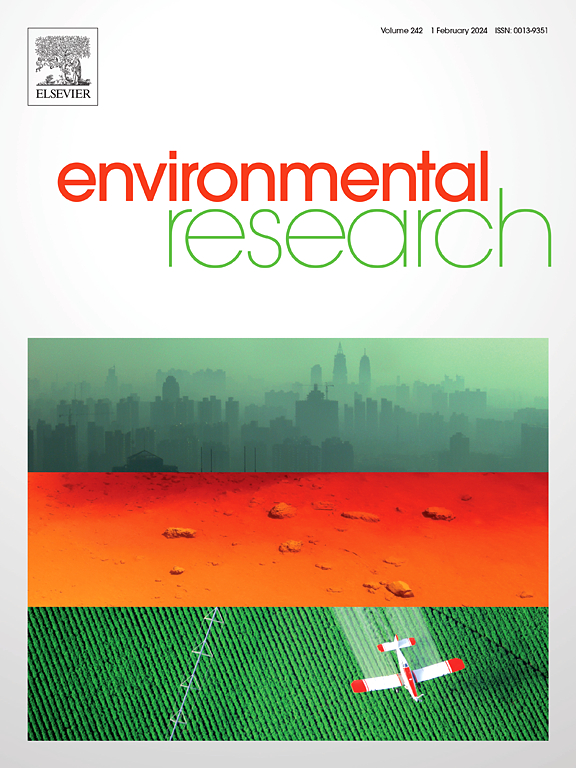Electroactive biofilm enhances synergistic degradation of sulfamethoxazole and roxarsone in actual livestock wastewater: extracellular electron transfer drives metabolic network remodeling
IF 7.7
2区 环境科学与生态学
Q1 ENVIRONMENTAL SCIENCES
引用次数: 0
Abstract
Livestock wastewater is characterized by high concentrations of organic matter and diverse antibiotics. A major challenge in its anaerobic treatment is the effective degradation and thorough removal of coexisting antibiotic contaminants. In this study, an external voltage was applied to establish an electroactive biofilm, thereby enhancing the co-metabolic degradation of sulfamethoxazole and roxarsone. Application of +0.6 V (Ag/AgCl) increased the 72 h TOC removal efficiency to 52.1 %. At the same time, sulfamethoxazole and roxarsone removal efficiencies reached 90.8 % and 100 %, respectively. The results from liquid chromatography-mass spectrometry (HPLC-MS/MS) and density functional theory calculations revealed sulfamethoxazole degradation pathways: N–O bond cleavage and hydroxylation. Roxarsone degradation primarily involved nitro group reduction and C–As bond cleavage. The pharmacophore of sulfamethoxazole was effectively removed, and inorganic arsenic from roxarsone degradation was efficiently immobilized. Toxicity analysis confirmed that the electroactive biofilm notably reduced toxic intermediate accumulation. Elevated concentrations of NADH and ATP in the electroactive biofilm indicated enhanced microbial substrate metabolism and generation of more electron donors. The higher absolute abundance of the sulfamethoxazole degradation gene (SadABC) in the electroactive biofilm indicated that sulfamethoxazole degrading enzyme (sadABC) gained more electrons. Microbiome analysis revealed the upregulation of genes linked to extracellular electron transfer, the tricarboxylic acid (TCA) cycle, nitro-reduction, and sulfate reduction pathway, confirming the electroactive biofilm enhances substrate metabolism and co-metabolic antibiotic degradation. Electroactive biofilm offers a viable strategy for antibiotic removal in livestock wastewater.
电活性生物膜增强了实际牲畜废水中磺胺甲恶唑和罗沙胂的协同降解:细胞外电子转移驱动代谢网络重塑。
畜牧业废水的特点是有机物浓度高,抗生素种类多。其厌氧处理的主要挑战是有效降解和彻底去除共存的抗生素污染物。在本研究中,施加外部电压建立电活性生物膜,从而增强磺胺甲恶唑和罗沙胂的共代谢降解。添加+0.6 V (Ag/AgCl), 72 h TOC去除率达到52.1%。同时,磺胺甲恶唑和洛克沙酮的去除率分别达到90.8%和100%。液相色谱-质谱(HPLC-MS/MS)和密度泛函理论(DFT)计算结果揭示了磺胺甲恶唑的降解途径:N-O键裂解和羟基化。洛克沙酮的降解主要涉及硝基还原和C-As键的裂解。磺胺甲恶唑的药效团被有效去除,洛克沙胂降解过程中的无机砷被有效固定化。毒性分析证实,电活性生物膜显著减少了毒性中间体的积累。电活性生物膜中NADH和ATP浓度的升高表明微生物底物代谢增强,产生更多的电子供体。电活性生物膜中磺胺甲恶唑降解基因(SadABC)的绝对丰度较高,表明磺胺甲恶唑降解酶(SadABC)获得了更多的电子。微生物组分析显示,与细胞外电子转移(EET)、三羧酸(TCA)循环、硝基还原和硫酸盐还原途径相关的基因上调,证实了电活性生物膜促进了底物代谢和共代谢抗生素降解。电活性生物膜为去除畜禽废水中的抗生素提供了一种可行的方法。
本文章由计算机程序翻译,如有差异,请以英文原文为准。
求助全文
约1分钟内获得全文
求助全文
来源期刊

Environmental Research
环境科学-公共卫生、环境卫生与职业卫生
CiteScore
12.60
自引率
8.40%
发文量
2480
审稿时长
4.7 months
期刊介绍:
The Environmental Research journal presents a broad range of interdisciplinary research, focused on addressing worldwide environmental concerns and featuring innovative findings. Our publication strives to explore relevant anthropogenic issues across various environmental sectors, showcasing practical applications in real-life settings.
 求助内容:
求助内容: 应助结果提醒方式:
应助结果提醒方式:


